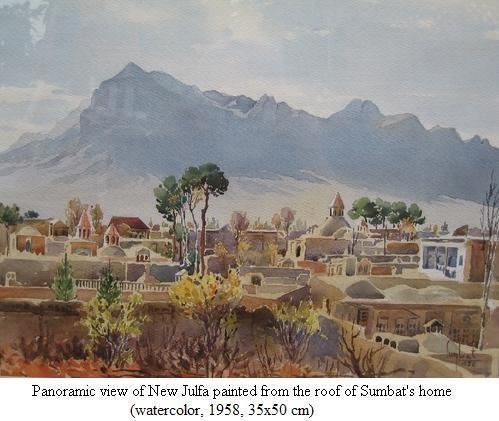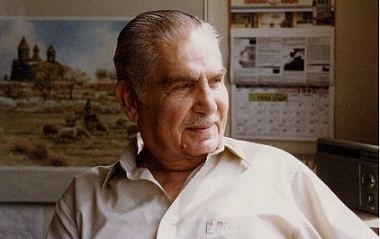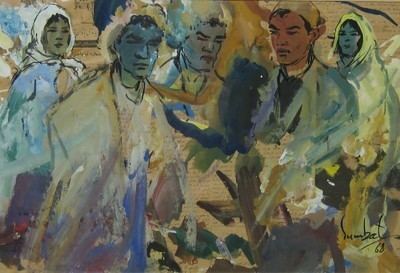Occupation artist | ||
 | ||
Died 9 June 1999, Los Angeles, California, United States | ||
Sumbat Der Kiureghian (Armenian: Սմբատ Տեր-Կյուրեղյան; October 19, 1913 – June 9, 1999) was a 20th century Iranian-Armenian watercolor artist.
Contents

Biography

Sumbat Der Kiureghian was born on October 19, 1913, in New Julfa (the Iranian city of Isfahan's Armenian quarter), in the family of Hovhannes Der Kiureghian and Tagouhi Haroutunian. Hovhannes was an auctioneer of specialty items and a watch repairman, who died in 1915. Therefore, Sumbat was raised by his mother, Tagouhi. Sumbat's grandfather Kiuregh served as a priest at the Sourb Hovhanou Church in New Julfa. The family took his priesthood name as their last name - Der Kiureghian; the "Der" part signifies lineage from a priest.
Career

Sumbat received his early education in the Armenian school in New Julfa. In 1924, he exhibited his paintings at a school contest and won a prize. His first art teacher at school was Yeghia Yegijanian, later Hacop Vardanian. After graduating from the Armenian school in New Julfa in 1929, Sumbat attended the Stuart Memorial English Collage for boys in Isfahan. There he learned English, Persian and other subjects. Later he enrolled in the art classes of Sarkis Khachadourian. Seeing Sumbat's abilities, Khachadourian recruited him as an apprentice to help him with his work. The experience had a tremendous influence on Sumbat and he opened his first studio on Charbagh Avenue at the age of seventeen. He used the studio both as a workplace and an exhibition hall. He also produced more popular handicraft items, such as painted vases and lampshades decorated with caravan scenes, and made designs of carpets. Sumbat's studio was a hangout for friends, and a group of them formed a musical band, in which Sumbat played the drums. In 1933, Sumbat closed his studio and entered compulsory military service for two years. After completing military service in 1935, Sumbat opened his second studio on Charbagh Avenue - Negarestan-eh Sumbat (Sumbat's Art Studio). By the time he graduated from college, Sumbat had greatly improved his skills as a watercolorist with light and easy brushwork, pure and translucent colors.

Sumbat preferred exhibiting his paintings in his studio. He first participated in a formal exhibition of paintings in April 1944 at the Anglo-Persian Institute in Isfahan. His next exhibition was in February 1948 in Abadan, where all exhibited paintings were sold and Sumbat received many commissions.

Stanley Foster, an English consulting engineer for the AIOC and an amateur artist, had a profound influence on Sumbat's career. He offered Sumbat to fund a six-month journey through the Middle East and Europe to England. On June 18, 1949 Sumbat and Stanley began their journey from Abadan, and traveling through Iraq and Syria to Lebanon they arrived in Naples, Italy by boat, then went on to Rome, Florence, Venice and Paris, arriving in London on August 13. During their travels they visited museums and historical sites and made numerous sketches and paintings. Sumbat was able to observe the works of great impressionists such as Monet, Degas and Pissaro, postimpressionists such as Cezanne, Toulouse-Lautrec and Van Gogh, and renowned British watercolorist Turner, who remained his favorites all his life.

Sumbat and Stanley enrolled in the Anglo-French Art Centre in London, where Sumbat received his first formal training. In London, they visited art galleries, museums and artists. Upon seeing Sumbat's watercolors, British watercolorist Sir W. Russell Flint declared him "brother in brush." In 1950, Sumbat held an exhibition of his watercolors from his travels in Europe and England at the Art Centre in London.
After his European travels, Sumbat used his newspaper palette as his canvas. With a few brush strokes, the random mix of gouache colors and printed letters came alive, suggesting a crowd in a traditional Iranian bazaar. In time, this technique, popularly known as "Sumbatism", became one of Sumbat's signature styles.
In the 1960s, Sumbat had become a well-known artist of the watercolor medium in Iran. His studio had become an institution in Isfahan and a popular destination for art-loving visitors and tourists. In 1965, Sumbat was invited by ARAMCO to Saudi Arabia to exhibit his paintings and teach art in Ras Tanura and Dhahran. The Saudi landscape and culture further enriched his experience. Further exhibitions were held in 1971 in Tehran and in 1976 in Los Angeles, during his first visit to the United States. In 1978, a major retrospective of Sumbat's works along with those of three other Iranian watercolorists was held in Tehran.
To be with their children, Sumbat and his wife Arax moved to the United States in 1980.
In 1991, Sumbat travelled to his ancestral homeland Armenia, and he held a major exhibition in the National Gallery of Armenia.
In 1993, Sumbat travelled to Iran. In Tehran, he participated in an exhibition together with younger artists. He then visited his hometown New Julfa in Isfahan, where a special event had been organized in his honor.
Death
Sumbat died in Los Angeles in 1999.
Sumbat Studis and Gallery
Family
On December 22, 1942 Sumbat married Arax Aftandilian. They had three children: Siroush (1945), Armen (1947), and Tagoush (1959).
